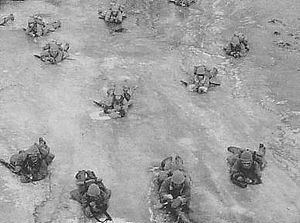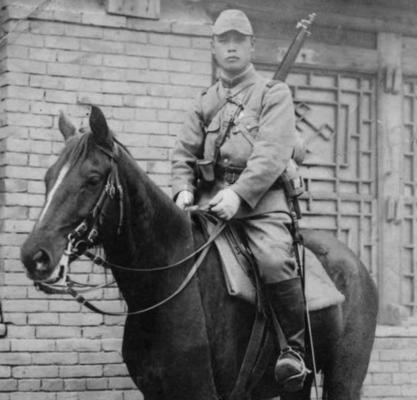Founded 1906 | ||
 | ||
Active April 1906 – August 1945 Similar Imperial Japanese Army, Manchukuo Imperial Army, Red Army, Eighth Route Army, National Revolutionary Army | ||
The Kwantung Army was an army group of the Imperial Japanese Army in the first half of the 20th century. It became the largest and most prestigious command in the IJA. Many of its personnel, such as Chiefs of staff Seishirō Itagaki and Hideki Tōjō were promoted to high positions in both the military and civil government in the Empire of Japan and it was largely responsible for the creation of the Japanese-dominated Empire of Manchukuo. In August 1945, the army group, only around 713,000 (from a previous total of 1,320,000) men at the time, was defeated by and surrendered to Soviet troops as a result of the Manchurian Strategic Offensive Operation.
Contents
- wwii japanese song anthem of the kwantung army w eng lyrics
- Formation
- Independent actions
- Second World War
- Surrender of the Kwantung Army
- War crimes and trials
- References

wwii japanese song anthem of the kwantung army w eng lyrics
Formation

Following the Russo-Japanese War, Japan obtained the Kwantung Leased Territory and the areas adjacent to the South Manchurian Railway. "Kwantung" means "east of Shanhaiguan", a guarded pass, east of which lies Manchuria. The Kwantung Garrison was established in 1906 to defend this territory, and originally was composed of an infantry division and a heavy siege artillery battalion, supplemented with six independent garrison battalions as railway guards deployed along the South Manchurian Railway Zone, for a total troop strength of 100,000 men. It was headquartered in Port Arthur, known as "Ryojun" in Japanese. After a reorganization in 1919, the Kwantung Garrison was renamed the Kwantung Army.

In the highly politicized Imperial Japanese Army of the 1920s and 1930s, the Kwantung Army was a stronghold of the radical "Imperial Way Faction", and many of its senior leaders overtly advocated political change in Japan through the violent overthrow of the civilian government to bring about a Shōwa Restoration, with a reorganization of society and the economy along totalitarian state fascist lines. They also advocated a more aggressive, expansionist foreign policy regarding the Asian mainland. Members or former members of the Kwantung Army were active in numerous coup d'état attempts against the civilian government, culminating with the February 26 Incident of 1936.
Independent actions

Although the Kwantung Army was nominally subordinate to the Imperial General Headquarters and the senior staff at the Army General Staff, its leadership often acted in direct violation of the orders from the mainland Japan without suffering any consequence. Conspirators within the junior officer corps of the Kwantung Army plotted and carried out the assassination of Manchurian warlord Chang Tsolin in the Huanggutun Incident of 1928. Afterwards, the Kwantung Army leadership engineered the Mukden Incident and the subsequent invasion of Manchuria in 1931 in a massive act of insubordination (gekokujo) against the express orders of the political and military leadership based in Tokyo.

Presented with the fait accompli, Imperial General Headquarters had little choice but to follow up on the actions of the Kwantung Army with reinforcements in the subsequent Pacification of Manchukuo. The success of the campaign meant that the insubordination of the Kwantung Army was rewarded rather than punished.

With the foundation of Manchukuo in 1932, the Kwantung Army played a controlling role in the political administration of the new state as well as in its defense. With the Kwantung Army administering all aspects of the politics and economic development of the new state, this made the Kwantung Army commanding officer equivalent to a Governor-general, with the authority to approve or countermand any command from the nominal emperor of Manchukuo, Puyi.
The Kwantung Army was heavily augmented over the next few years, up to a strength of 700,000 troops by 1941, and its headquarters was transferred to the new Manchukuo capital of Hsinking. The Kwantung Army also oversaw the creation, training, and equipping of an auxiliary force, the Manchukuo Imperial Army. During this time, Prince Tsuneyoshi Takeda worked as liaison officer between the Imperial house and the Kwantung Army.
Second World War
After the campaign to secure Manchukuo, the Kwantung Army continued to fight in numerous border skirmishes with China as part of its efforts to create a Japanese-dominated buffer zone in northern China. The Kwantung Army also fought in the opening phase of the Second Sino-Japanese War in Operation Nekka, and various actions in Inner Mongolia to extend Japanese domination over portions of northern China and Inner Mongolia. When war broke out in the Marco Polo Bridge Incident in July 1937, its forces participated in Battle of Beiping-Tianjin and Operation Chahar. Later, Kwantung forces supported the war in China from time to time.
However, the much vaunted reputation of the Kwantung Army was severely challenged in battle against the Soviet Union's Red Army at the Battle of Lake Khasan in 1938 and subsequent Battle of Nomonhan in 1939, during which time it sustained heavy casualties. After the Nomonhan incident, the Kwantung Army was purged of its more insubordinate elements, as well as proponents of the Hokushin-ron ("Northward Advance") doctrine who urged that Japan concentrate its expansionist efforts on Siberia rather southward towards China and Southeast Asia.
Although a source of constant unrest during the 1930s, the Kwantung Army remained remarkably obedient during the 1940s. As combat spread south into central China and southern China in the Second Sino-Japanese War, and with the outbreak of the Pacific War, Manchukuo was largely a backwater to the conflict.
However, as the war situation began to deteriorate for the Imperial Japanese Army on all fronts, the large, well-trained, and well-equipped Kwantung Army could no longer be held in strategic reserve. Many of its front line units were systematically stripped of their best units and equipment, which were sent south against the forces of the United States in the Pacific Islands or the Philippines. Other units were sent south into China for Operation Ichi-Go.
Surrender of the Kwantung Army
By 1945, the Kwantung Army consisted of a mere 713,000 personnel, divided into 31 infantry divisions, nine infantry brigades, two tank brigades, and one special purpose brigade. It also possessed 1,155 light tanks, 5,360 guns, and 1,800 aircraft. The quality of troops had fallen drastically, as all the best men and materiel were siphoned off for use in other theaters. These forces were replaced by militia, draft levies, reservists, and cannibalized smaller units, all equipped with woefully outdated equipment. The Kwantung Army had also bacteriological weapons, prepared for use against Soviet troops (see. "Detachment 731"). The bulk of military equipment (artillery, tanks, aircraft) was developed in the 1930s, and very few of the soldiers had sufficient training or any real experience.
The final commanding officer of the Kwantung Army, General Otozō Yamada, ordered a surrender on August 16, 1945, one day after Emperor Hirohito announced the surrender of Japan in a radio announcement. Some Japanese divisions refused to surrender, and combat continued for the next few days. Marshal Hata received the "ultimatum to surrender" from Soviet General Georgii Shelakhov in Harbin on August 18, 1945. He was one of the senior generals who agreed with the decision to surrender, and on August 19, 1945, Hata met with Marshal Aleksandr Vasilevsky, but asked that he be stripped of his rank of Field Marshal in atonement for the Army's failures in the war.
The remnants of the Kwantung Army were either dead or on their way to Soviet prisoner-of-war camps. Over 500,000 Japanese prisoners of war were sent to work in Soviet labor camps in Siberia, Russian Far East and Mongolia. They were largely repatriated, in stages, over the next five years, though some continued to be held well into the 1950s.
War crimes and trials
After the surrender of Japan, the Soviet Red Army discovered secret installations for experimenting with and producing chemical weapons and biological weapons of mass destruction centered around secret Army Unit 731 and its subsidiaries. At these locations, the Kwantung Army was also responsible for some of the most infamous Japanese war crimes, including the operation of several human experimentation programs using live Chinese, American and Russian civilians, and POWs, directed by Dr. Shiro Ishii.
Arrested by the American occupation authorities, Ishii and the 20,000 members of Unit 731 received immunity from prosecution of war-crimes before the Tokyo tribunal of 1948, in exchange for germ warfare data based on human experimentation. On May 6, 1947, General Douglas MacArthur wrote to Washington that "additional data, possibly some statements from Ishii probably can be obtained by informing Japanese involved that information will be retained in intelligence channels and will not be employed as 'War Crimes' evidence". The deal was concluded in 1948. However, twelve members of Unit 731 and some members of the World War II leadership of the Kwantung Army were sentenced as war criminals by the Khabarovsk War Crime Trials, while others were taken into custody by the United States, and sentenced at the 1948 International Military Tribunal for the Far East in Tokyo. Among those sentenced to death were former generals Seishirō Itagaki, Iwane Matsui, Kenji Doihara, Hideki Tōjō and Akira Mutō.
